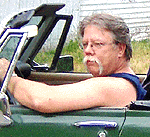1⁄35Building a Panzer IVJ - Part 1

The next level of drybrush is the artsy level. Itís sole purpose is to give
depth to the model by artificially lightening the higher spots to contrast the
shadowy wash. You may simply add some white to your basecoat or use a lighter
shade of a different color-itís a matter of choice. I used interior buff. This
drybrush should be about half the pressure used in the first session. Trying to
get just the highest spots to pick up the pigment .
The final level of drybrushing is once again a realistic level. It will cover
some of the previous ďartsyĒ level but thatís O.K. It just doesnít look right if
you donít have that ďartsyĒ level underneath, one of those...ĒI canít put my
finger on it but it donít look quite rightĒ things. Get a 1/4Ē soft brush and
your bottle of Model Master buffing exhaust metalizer paint. This drybrush will
hit the areas of highest wear. Fender edges, turret top edges, tow hooks lower
hull edges.....basically anywhere the paint has been totally worn off. Model
Master exhaust is very dark-almost black, and I think the perfect color for bare
metal on armored vehicles. I never want to see silver drybrushed on a tank!
(Note: The only exception is drive-sprocket teeth.) Once you have the corners and edges drybrushed get your brush to a point where you can drybrush a pattern of
scratches and hit the hull front, the front of the gun barrel turret and hull
sides, anywhere that the paint may be scratched and scraped off. Donít paint the
tip of your gum barrel black to simulate a sooty build up. Unless the tip of the
barrel of the tank your building was painted black it should not be given a
sooty look. Tank ammo did not blacken the end of the barrel. Maybe after
thousands of rounds and no cleaning...This is another artsy thing some modelers
do. Maybe you think Iím wrong? Maybe I am? Show us some wartime photos... Next take that thin brush and the exhaust paint and just randomly
put some specks here and there for chipped paint.








